HPLC Fingerprints for the Characterization of Walnuts and the Detection of Fraudulent Incidents
Abstract
:1. Introduction
2. Materials and Methods
2.1. Chemicals and Reagents
2.2. Instrumentation
2.3. Chromatographic Analysis
2.4. Walnut Samples
2.5. Extraction Optimization
2.6. Sample Preparation
2.7. Method Validation
2.8. Chemometric Analysis
3. Results
3.1. Extraction Optimization Results
3.2. Method Validation Results
3.3. Walnut Analysis
Quantification Results
3.4. PLS-DA Model
4. Conclusions
Author Contributions
Funding
Acknowledgments
Conflicts of Interest
References
- Dennis, M.J. Recent developments in food authentication†. Analyst 1998, 123, 151–156. [Google Scholar] [CrossRef]
- Production, F.; Cervantes-Godoy, D.; Dewbre, J.; PIN; Amegnaglo, C.J.; Soglo, Y.Y.; Akpa, A.F.; Bickel, M.; Sanyang, S.; Ly, S.; et al. The Future of Food and Agriculture: Trends and Challenges; Food and Agriculture Organization of the United Nations: Rome, Italy, 2017; Volume 4, ISBN 1815-6797. [Google Scholar]
- Abdallah, I.B.; Tlili, N.; Martinez-Force, E.; Rubio, A.G.P.; Perez-Camino, M.C.; Albouchi, A.; Boukhchina, S. Content of carotenoids, tocopherols, sterols, triterpenic and aliphatic alcohols, and volatile compounds in six walnuts (Juglans regia L.) varieties. Food Chem. 2015, 173, 972–978. [Google Scholar] [CrossRef] [Green Version]
- Martinez, M.L.; O Labuckas, D.; Lamarque, A.L.; Maestri, D.M. Walnut (Juglans regia L.): Genetic resources, chemistry, by-products. J. Sci. Food Agric. 2010, 90, 1959–1967. [Google Scholar] [CrossRef]
- Kalogiouri, N.; Manousi, N.; Zachariadis, G. Determination of the Toxic and Nutrient Element Content of Almonds, Walnuts, Hazelnuts and Pistachios by ICP-AES. Separations 2021, 8, 28. [Google Scholar] [CrossRef]
- Poggetti, L.; Ferfuia, C.; Chiabà, C.; Testolin, R.; Baldini, M. Kernel oil content and oil composition in walnut (Juglans regia L.) accessions from north-eastern Italy. J. Sci. Food Agric. 2017, 98, 955–962. [Google Scholar] [CrossRef] [Green Version]
- Gandev, S.; Arnaudov, V.; Serbezova, D. Selection and cultivation of a local wild walnut type in Bulgaria. Acta Hortic. 2015, 135–139. [Google Scholar] [CrossRef]
- Kalogiouri, N.P.; Manousi, N.; Rosenberg, E.; Zachariadis, G.A.; Samanidou, V.F. Advances in the Chromatographic Separation and Determination of Bioactive Compounds for Assessing the Nutrient Profile of Nuts. Curr. Anal. Chem. 2021, 17, 495–511. [Google Scholar] [CrossRef]
- Maguire, L.S.; O’Sullivan, S.M.; Galvin, K.; O’Connor, T.P.; O’Brien, N.M. Fatty acid profile, tocopherol, squalene and phytosterol content of walnuts, almonds, peanuts, hazelnuts and the macadamia nut. Int. J. Food Sci. Nutr. 2004, 55, 171–178. [Google Scholar] [CrossRef] [PubMed]
- Lavedrine, F.; Ravel, A.; Poupard, A.; Alary, J. Effect of geographic origin, variety and storage on tocopherol concentrations in walnuts by HPLC. Food Chem. 1997, 58, 135–140. [Google Scholar] [CrossRef]
- Martinez, M.L.; Mattea, M.A.; Maestri, D.M. Varietal and crop year effects on lipid composition of walnut (Juglans regia) genotypes. J. Am. Oil Chem. Soc. 2006, 83, 791–796. [Google Scholar] [CrossRef]
- Amaral, J.; Casal, S.; Pereira, J.A.; Seabra, R.M.; Oliveira, B. Determination of Sterol and Fatty Acid Compositions, Oxidative Stability, and Nutritional Value of Six Walnut (Juglans regia L.) Cultivars Grown in Portugal. J. Agric. Food Chem. 2003, 51, 7698–7702. [Google Scholar] [CrossRef] [Green Version]
- Pereira, J.A.; Oliveira, I.; Sousa, A.; Ferreira, I.; Bento, A.A.; Estevinho, M.L.M.F. Bioactive properties and chemical composition of six walnut (Juglans regia L.) cultivars. Food Chem. Toxicol. 2008, 46, 2103–2111. [Google Scholar] [CrossRef]
- Kalogiouri, N.P.; Manousi, N.; Rosenberg, E.; Zachariadis, G.A.; Paraskevopoulou, A.; Samanidou, V. Exploring the volatile metabolome of conventional and organic walnut oils by solid-phase microextraction and analysis by GC-MS combined with chemometrics. Food Chem. 2021, 363, 130331. [Google Scholar] [CrossRef]
- Cindrić, I.J.; Zeiner, M.; Hlebec, D. Mineral Composition of Elements in Walnuts and Walnut Oils. Int. J. Environ. Res. Public Health 2018, 15, 2674. [Google Scholar] [CrossRef] [PubMed] [Green Version]
- Lavedrine, F.; Ravel, A.; Villet, A.; Ducros, V.; Alary, J. Mineral composition of two walnut cultivars originating in France and California. Food Chem. 2000, 68, 347–351. [Google Scholar] [CrossRef]
- Lavedrine, F.; Zmirou, D.; Ravel, A.; Balducci, F.; Alary, J. Blood Cholesterol and Walnut Consumption: A Cross-sectional Survey in France. Prev. Med. 1999, 28, 333–339. [Google Scholar] [CrossRef]
- Verardo, V.; Bendini, A.; Cerretani, L.; Malaguti, D.; Cozzolino, E.; Caboni, M.F. Capillary Gas Chromatography Analysis of Lipid Composition and Evaluation of Phenolic Compounds by Micellar Electrokinetic Chromatography in Italian Walnut (Juglans Regial): Irrigation and Fertilization Influence. J. Food Qual. 2009, 32, 262–281. [Google Scholar] [CrossRef]
- Dogan, M.; Akgül, A. Fatty acid composition of some walnut (Juglans regia L.) cultivars from east Anatolia. Grasas Aceites 2005, 56, 328–331. [Google Scholar] [CrossRef] [Green Version]
- Lee, J.; Vázquez-Araújo, L.; Adhikari, K.; Warmund, M.; Elmore, J. Volatile Compounds in Light, Medium, and Dark Black Walnut and Their Influence on the Sensory Aromatic Profile. J. Food Sci. 2011, 76, C199–C204. [Google Scholar] [CrossRef]
- Esteki, M.; Farajmand, B.; Amanifar, S.; Barkhordari, R.; Ahadiyan, Z.; Dashtaki, E.; Mohammadlou, M.; Heyden, Y.V. Classification and authentication of Iranian walnuts according to their geographical origin based on gas chromatographic fatty acid fingerprint analysis using pattern recognition methods. Chemom. Intell. Lab. Syst. 2017, 171, 251–258. [Google Scholar] [CrossRef]
- Grilo, F.; Wang, S. Walnut (Juglans regia L.) Volatile Compounds Indicate Kernel and Oil Oxidation. Foods 2021, 10, 329. [Google Scholar] [CrossRef]
- Medic, A.; Jakopic, J.; Hudina, M.; Solar, A.; Veberic, R. Identification and quantification of the major phenolic constituents in Juglans regia L. peeled kernels and pellicles, using HPLC–MS/MS. Food Chem. 2021, 352, 129404. [Google Scholar] [CrossRef]
- Kritikou, E.; Kalogiouri, N.P.; Kolyvira, L.; Thomaidis, N.S. Target and Suspect HRMS Metabolomics for the Determination of Functional Ingredients in 13 Varieties of Olive Leaves and Drupes from Greece. Molecules 2020, 25, 4889. [Google Scholar] [CrossRef] [PubMed]
- Andrade, P.; Pereira, D.; Ferreres, F.; Valentao, P. Recent Trends in High Throughput Analysis and Antioxidant Potential Screening for Phenolics. Curr. Pharm. Anal. 2008, 4, 137–150. [Google Scholar] [CrossRef]
- Kalogiouri, N.; Samanidou, V. Advances in the Optimization of Chromatographic Conditions for the Separation of Antioxidants in Functional Foods. Rev. Sep. Sci. 2019, 1, 17–33. [Google Scholar] [CrossRef]
- Pyrzynska, K.; Sentkowska, A. Recent Developments in the HPLC Separation of Phenolic Food Compounds. Crit. Rev. Anal. Chem. 2014, 45, 41–51. [Google Scholar] [CrossRef]
- Rodríguez, L.C.; Ruiz-Samblás, C.; Valverde-Som, L.; Pérez-Castaño, E.; González-Casado, A. Chromatographic fingerprinting: An innovative approach for food ‘identitation’ and food authentication—A tutorial. Anal. Chim. Acta 2016, 909, 9–23. [Google Scholar] [CrossRef]
- Wang, Y.-P.; Zou, Y.-R.; Shi, J.-T.; Shi, J. Review of the chemometrics application in oil-oil and oil-source rock correlations. J. Nat. Gas Geosci. 2018, 3, 217–232. [Google Scholar] [CrossRef]
- Jolliffe, I.T.; Cadima, J. Principal component analysis: A review and recent developments. Philos. Trans. R. Soc. A Math. Phys. Eng. Sci. 2016, 374, 20150202. [Google Scholar] [CrossRef] [PubMed]
- Brereton, R.G.; Lloyd, G. Partial least squares discriminant analysis: Taking the magic away. J. Chemom. 2014, 28, 213–225. [Google Scholar] [CrossRef]
- Kalogiouri, N.P.; Samanidou, V.F. Liquid chromatographic methods coupled to chemometrics: A short review to present the key workflow for the investigation of wine phenolic composition as it is affected by environmental factors. Environ. Sci. Pollut. Res. 2020, 1–15. [Google Scholar] [CrossRef] [PubMed]
- Pinasseau, L.; Vallverdú-Queralt, A.; Verbaere, A.; Roques, M.; Meudec, E.; Le Cunff, L.; Péros, J.-P.; Ageorges, A.; Sommerer, N.; Boulet, J.-C.; et al. Cultivar Diversity of Grape Skin Polyphenol Composition and Changes in Response to Drought Investigated by LC-MS Based Metabolomics. Front. Plant Sci. 2017, 8, 1826. [Google Scholar] [CrossRef] [Green Version]
- Czitrom, V. One-Factor-at-a-Time versus Designed Experiments. Am. Stat. 1999, 53, 126. [Google Scholar] [CrossRef]
- Rifna, E.J.; Pandiselvam, R.; Kothakota, A.; Subba Rao, K.V.; Dwivedi, M.; Kumar, M.; Thirumdas, R.; Ramesh, S.V. Advanced process analytical tools for identification of adulterants in edible oils—A review. Food Chem. 2022, 369, 130898. [Google Scholar] [CrossRef]
- Pang, Z.; Chong, J.; Zhou, G.; de Lima Morais, D.A.; Chang, L.; Barrette, M.; Gauthier, C.; Jacques, P.; Li, S.; Xia, J. MetaboAnalyst 5.0: Narrowing the gap between raw spectra and functional insights. Nucleic Acids Res. 2021, 49, W388–W396. [Google Scholar] [CrossRef]
- Setyaningsih, W.; Saputro, I.E.; Palma, M.; Barroso, C.G. Stability of 40 phenolic compounds during ultrasound-assisted extractions (UAE). In AIP Conference Proceedings; AIP Publishing LLC: Melville, NY, USA, 2016; Volume 1755, p. 080009. [Google Scholar] [CrossRef] [Green Version]
- Slatnar, A.; Mikulic-Petkovsek, M.; Stampar, F.; Veberic, R.; Solar, A. Identification and quantification of phenolic compounds in kernels, oil and bagasse pellets of common walnut (Juglans regia L.). Food Res. Int. 2015, 67, 255–263. [Google Scholar] [CrossRef]
- Ho, K.-V.; Roy, A.; Foote, S.; Vo, P.H.; Lall, N.; Lin, C.-H. Profiling Anticancer and Antioxidant Activities of Phenolic Compounds Present in Black Walnuts (Juglans nigra) Using a High-Throughput Screening Approach. Molecules 2020, 25, 4516. [Google Scholar] [CrossRef]
- Vu, D.C.; Vo, P.H.; Coggeshall, M.V.; Lin, C.-H. Identification and Characterization of Phenolic Compounds in Black Walnut Kernels. J. Agric. Food Chem. 2018, 66, 4503–4511. [Google Scholar] [CrossRef] [PubMed]
- Mehmood, T.; Liland, K.H.; Snipen, L.; Sæbø, S. A review of variable selection methods in Partial Least Squares Regression. Chemom. Intell. Lab. Syst. 2012, 118, 62–69. [Google Scholar] [CrossRef]
- Szymańska, E.; Saccenti, E.; Smilde, A.K.; Westerhuis, J.A. Double-check: Validation of diagnostic statistics for PLS-DA models in metabolomics studies. Metabolomics 2011, 8, 3–16. [Google Scholar] [CrossRef] [Green Version]
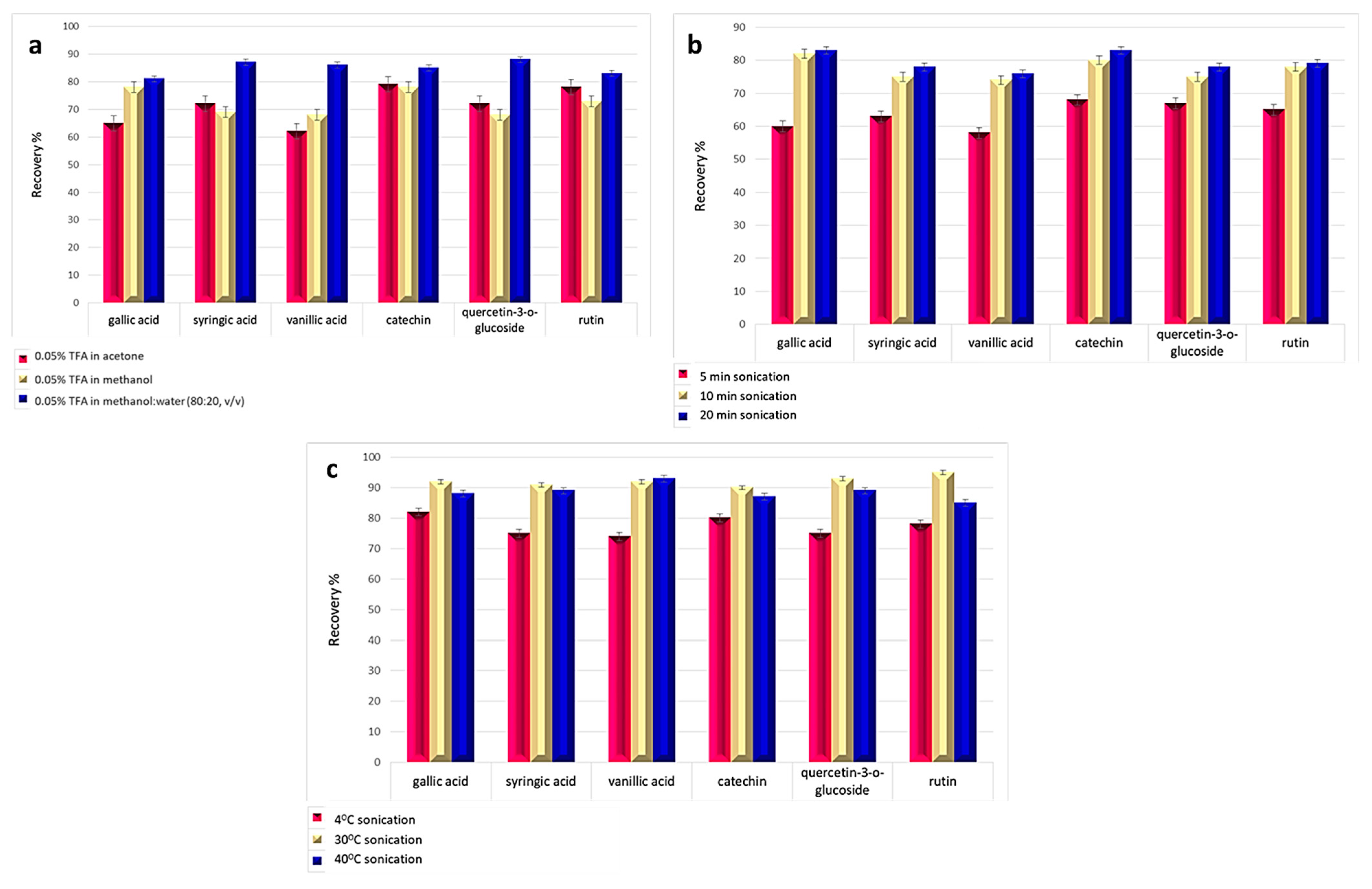
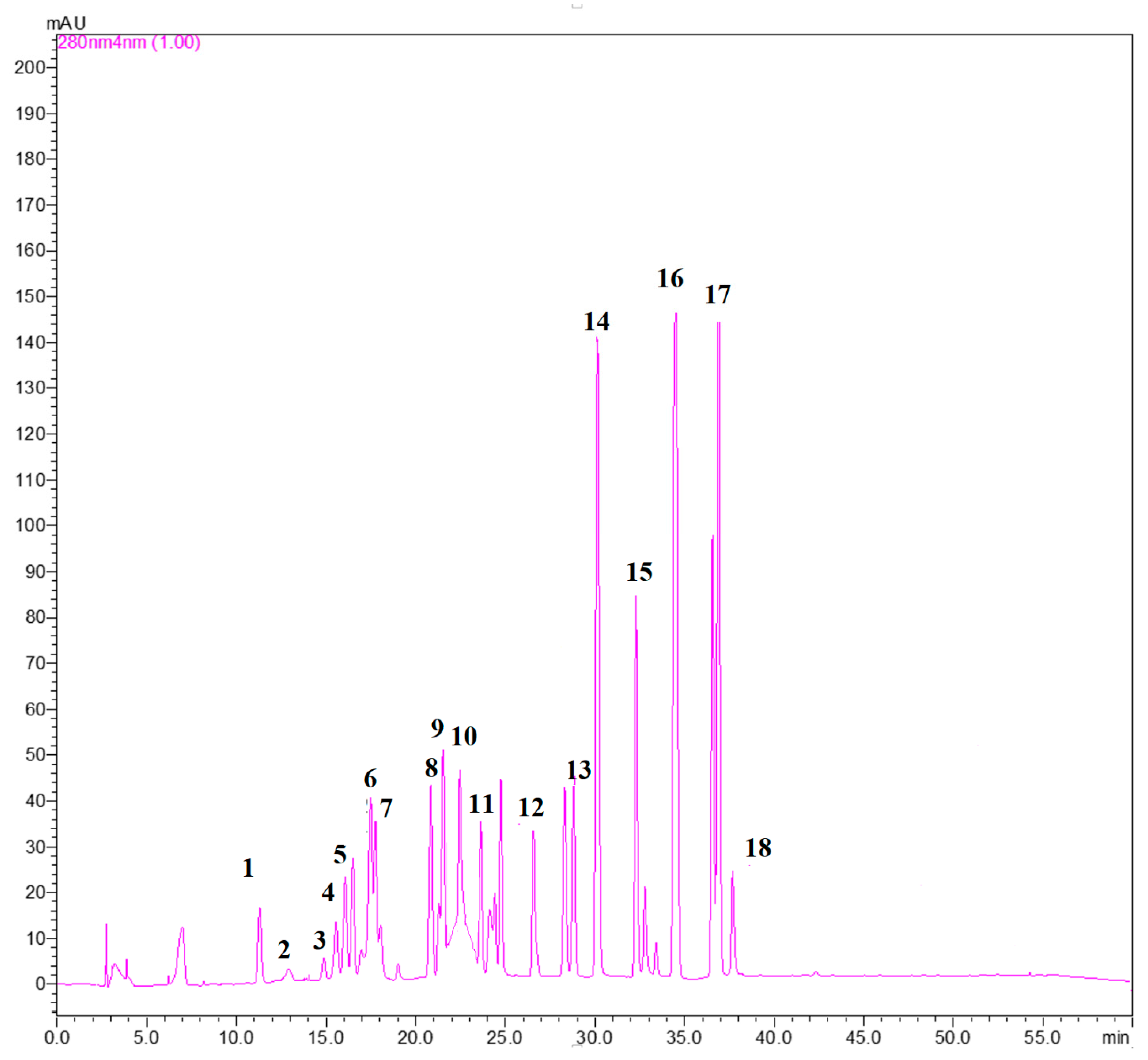
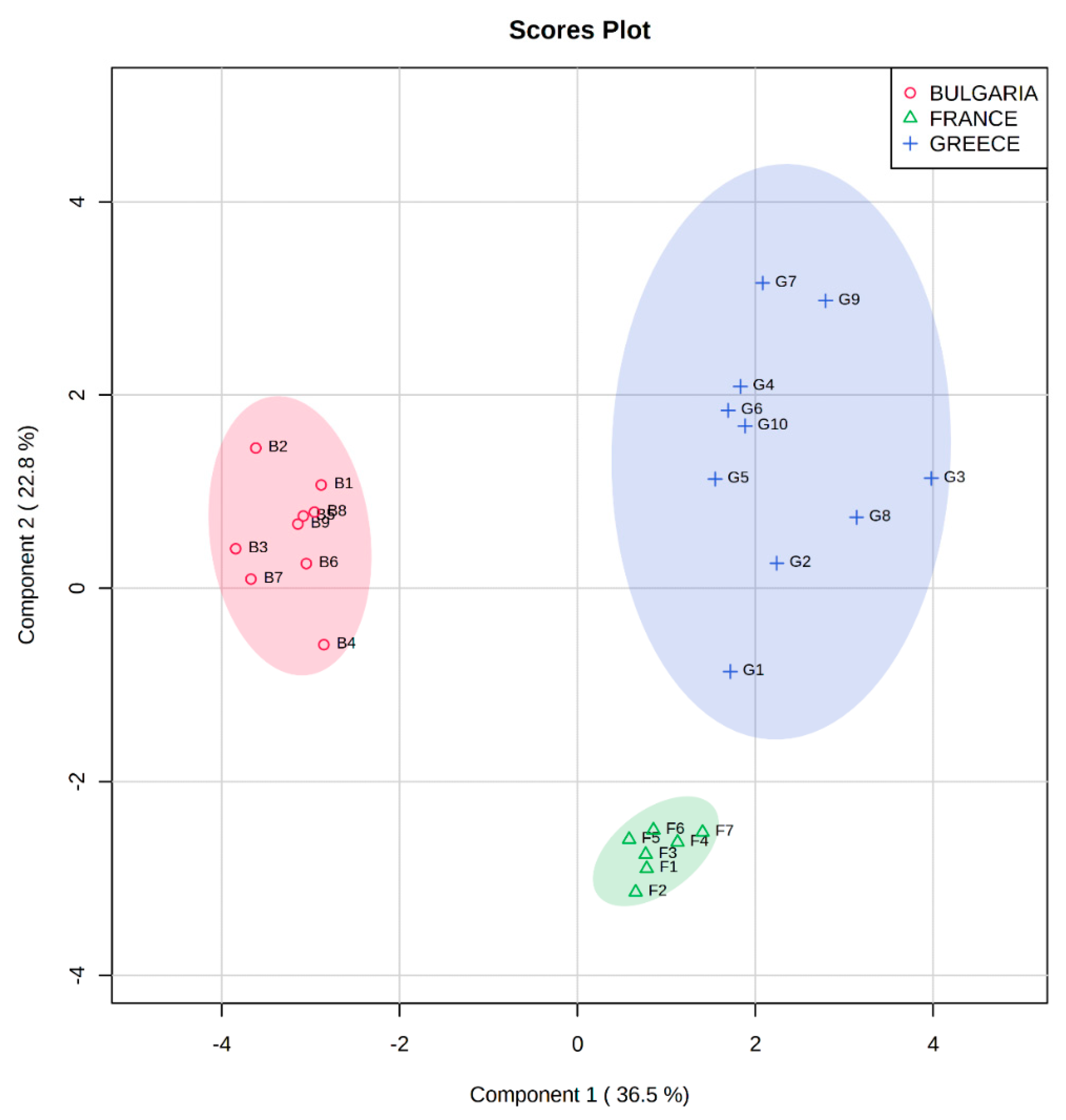
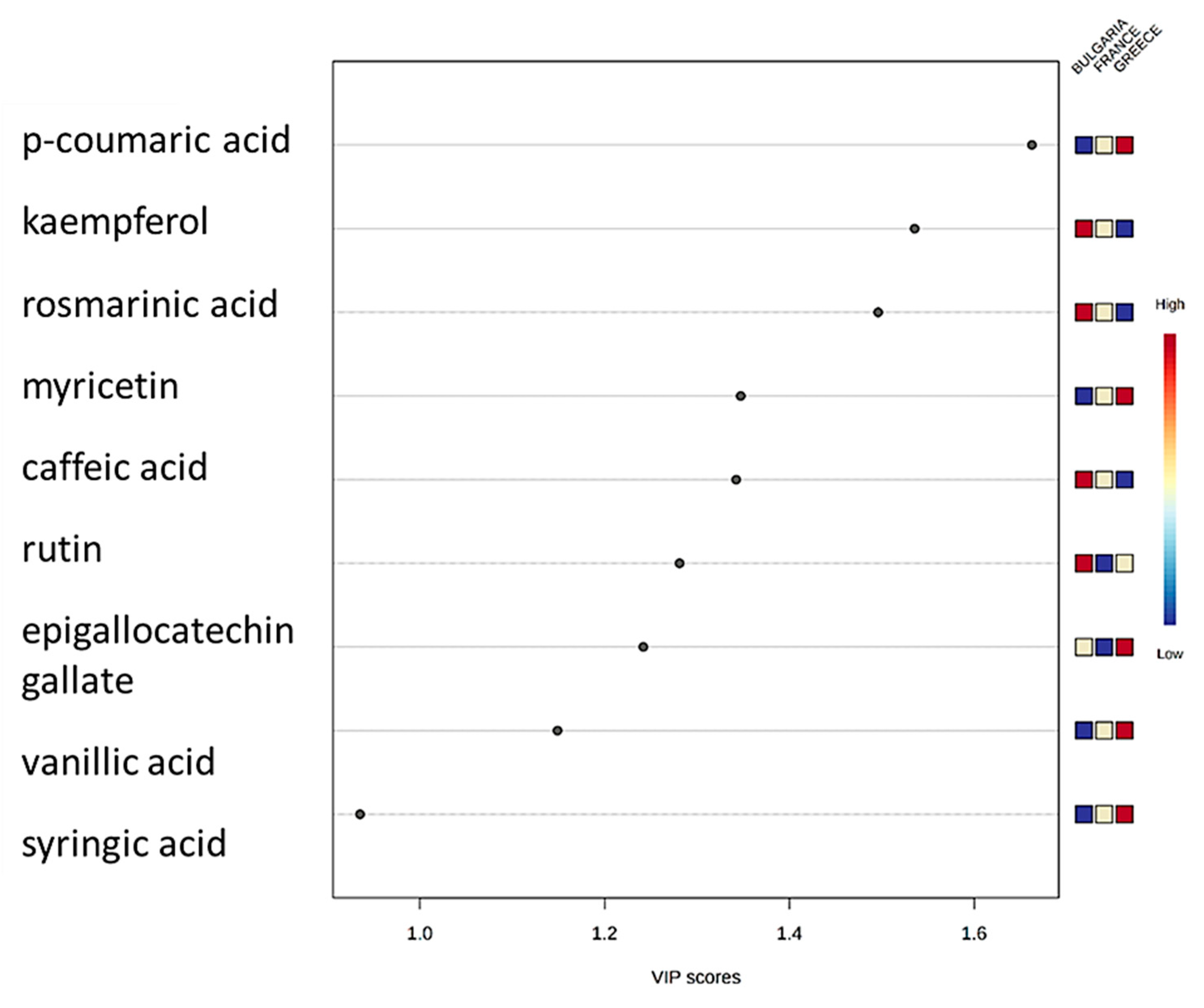
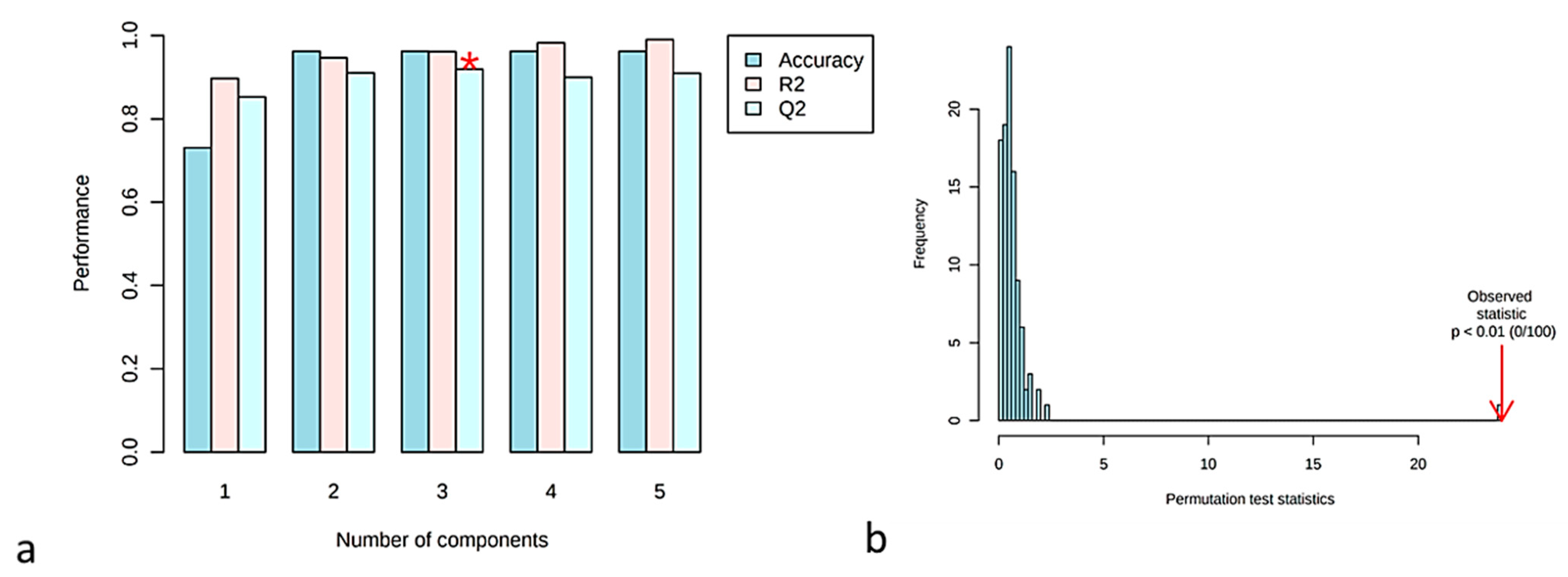
| Compound | Calibration Equation (Linear Range: 2–20 μg/g) | r2 | LOD (μg/g) | LOQ (μg/g) |
|---|---|---|---|---|
| caffeic acid | y = 110028.53x + 5532 | 0.992 | 0.15 | 0.45 |
| catechin | y = 12565x + 1204 | 0.994 | 0.30 | 0.90 |
| diosmin | y = 14007.23x + 1353 | 0.991 | 0.20 | 0.60 |
| epigallocatechin gallate | y = 19304x − 1212 | 0.996 | 0.40 | 1.20 |
| ferulic acid | y = 88455x + 4328 | 0.994 | 0.25 | 0.75 |
| gallic acid | y = 10562x − 11.8 | 0.997 | 0.10 | 0.30 |
| gallocatechin gallate | y = 2004x − 1450 | 0.996 | 0.45 | 1.35 |
| kaempferol | y = 1878x + 2242 | 0.998 | 0.45 | 1.35 |
| myricetin | y = 19502x + 1026 | 0.997 | 0.48 | 1.44 |
| myricitrin | y = 20521x + 1408 | 0.996 | 0.32 | 0.96 |
| p-coumaric acid | y = 107385x + 4325 | 0.999 | 0.25 | 0.75 |
| quercetin-3-o-glucoside | y = 17542x + 2404 | 0.997 | 0.28 | 0.84 |
| rosmarinic acid | y = 1508x + 48.3 | 0.998 | 0.15 | 0.45 |
| sinapic acid | y = 107562x + 2385 | 0.994 | 0.24 | 0.72 |
| rutin | y = 20008x + 423 | 0.993 | 0.34 | 0.96 |
| syringic acid | y = 105424x + 4728 | 0.995 | 0.25 | 0.75 |
| vanillic acid | y = 65405x + 1125 | 0.998 | 0.20 | 0.60 |
| vanillin | y = 138452x − 4585 | 0.994 | 0.35 | 1.05 |
| caffeic acid | y = 125475x + 1842 | 0.993 | 0.20 | 0.60 |
| Compound | %R Low Conc. Level (2 μg/g) | %RSD | %R Medium Conc. Level (10 μg/g) | %RSD | %R Maximum Conc. Level (20 μg/g) | %RSD |
|---|---|---|---|---|---|---|
| caffeic acid | 91.4 | 4.7 | 92.5 | 2.2 | 98.4 | 2.5 |
| catechin | 90.5 | 5.5 | 94.4 | 3.1 | 91.2 | 1.7 |
| diosmin | 96.4 | 3.1 | 95.6 | 5.1 | 93.6 | 3.9 |
| epigallocatechin gallate | 92.3 | 1.3 | 90.8 | 4.4 | 94.1 | 4.2 |
| ferulic acid | 91.7 | 2.5 | 91.7 | 6.1 | 90.8 | 5.1 |
| gallic acid | 92.1 | 3.6 | 92.4 | 3.1 | 92.1 | 6.3 |
| gallocatechin gallate | 93.3 | 4.1 | 91.6 | 2.4 | 94.6 | 5.5 |
| kaempferol | 91.8 | 5.2 | 89.7 | 5.3 | 92.8 | 3.7 |
| myricetin | 90.9 | 4.3 | 92.4 | 1.8 | 93.5 | 4.9 |
| myricitrin | 94.5 | 1.9 | 93.2 | 2.6 | 94.3 | 3.4 |
| p-coumaric acid | 95.6 | 2.5 | 91.4 | 3.1 | 91.1 | 4.8 |
| quercetin-3-o-glucoside | 93.0 | 2.7 | 95.2 | 5.4 | 93.1 | 2.7 |
| rosmarinic acid | 92.2 | 3.5 | 93.7 | 4.9 | 89.4 | 5.6 |
| sinapic acid | 91.1 | 2.8 | 92.4 | 6.3 | 86.4 | 2.8 |
| rutin | 94.2 | 3.6 | 93.5 | 3.9 | 92.6 | 5.7 |
| syringic acid | 93.1 | 5.4 | 92.6 | 2.7 | 92.3 | 6.2 |
| vanillic acid | 92.8 | 6.2 | 90.7 | 1.6 | 94.5 | 4.3 |
| vanillin | 93.7 | 5.1 | 92.4 | 3.5 | 93.9 | 2.5 |
| Compound | %R Low Conc. Level (2 μg/g) | %RSD | %R Medium Conc. Level (10 μg/g) | %RSD | %R Maximum Conc. Level (10 μg/g) | %RSD |
|---|---|---|---|---|---|---|
| caffeic acid | 95.3 | 5.3 | 97.2 | 7.2 | 93.2 | 7.2 |
| catechin | 92.8 | 7.1 | 96.5 | 5.4 | 92.4 | 6.8 |
| diosmin | 97.4 | 8.8 | 93.1 | 4.8 | 91.5 | 5.5 |
| epigallocatechin gallate | 93.5 | 7.9 | 91.4 | 9.1 | 94.3 | 5.9 |
| ferulic acid | 97.1 | 6.3 | 95.8 | 7.4 | 92.2 | 6.4 |
| gallic acid | 98.2 | 6.8 | 100.6 | 5.2 | 95.6 | 7.1 |
| gallocatechin gallate | 91.9 | 7.2 | 97.8 | 6.6 | 90.1 | 6.9 |
| kaempferol | 95.1 | 9.4 | 93.5 | 5.4 | 92.4 | 7.3 |
| myricetin | 93.7 | 8.3 | 94.2 | 8.8 | 93.3 | 8.1 |
| myricitrin | 92.2 | 7.6 | 96.6 | 7.1 | 96.1 | 6.5 |
| p-coumaric acid | 91.6 | 6.7 | 95.1 | 11.1 | 95.5 | 7.1 |
| quercetin-3-o-glucoside | 94.4 | 8.5 | 98.3 | 5.9 | 94.7 | 6.8 |
| rosmarinic acid | 92.3 | 9.1 | 95.7 | 8.7 | 92.1 | 5.2 |
| sinapic acid | 91.7 | 7.5 | 97.5 | 9.1 | 91.5 | 3.4 |
| rutin | 92.2 | 7.1 | 98.2 | 6.7 | 95.5 | 9.2 |
| syringic acid | 90.5 | 8.3 | 91.1 | 5.8 | 90.7 | 6.5 |
| vanillic acid | 93.1 | 8.4 | 95.3 | 7.3 | 91.1 | 5.8 |
| vanillin | 94.4 | 5.7 | 92.4 | 6.4 | 92.1 | 7.5 |
| Compound | Rt | λ (nm) |
|---|---|---|
| gallic acid | 11.1 | 278 |
| gallocatechin gallate | 12.6 | 285 |
| catechin | 14.6 | 280 |
| vanillic acid | 15.5 | 260 |
| epigallocatechin gallate | 17.4 | 280 |
| syringic acid | 18.1 | 274 |
| rutin | 19.3 | 353 |
| myricitrin | 20.6 | 360 |
| p-coumaric acid | 21.4 | 270 |
| vanillin | 22.6 | 278 |
| sinapic acid | 23.5 | 260 |
| quercetin-3-o-glucoside | 26.5 | 365 |
| diosmin | 28.8 | 345 |
| ferulic acid | 29.8 | 293 |
| caffeic acid | 32.2 | 284 |
| myricetin | 34.3 | 370 |
| rosmarinic acid | 37.1 | 272 |
| kaempferol | 37.9 | 360 |
| Origin | Greece | Bulgaria | France | |||
|---|---|---|---|---|---|---|
| Compound | Concentration Range (μg/g) | Mean Value (μg/g ± SD) | Concentration Range (μg/g) | Mean Value (μg/g ± SD) | Concentration Range (μg/g) | Mean Value (μg/g ± SD) |
| caffeic acid | LOQ–2.56 | 2.05 ± 0.28 | 2.67–5.58 | 4.25 ± 0.54 | 2.35–4.42 | 3.65 ± 0.33 |
| catechin | 78–148 | 81.5 ± 5.24 | 34–122 | 75.1 ± 2.35 | 4.21–75.3 | 34.2 ± 6.05 |
| diosmin | LOQ–23.8 | 4.32 ± 0.14 | LOQ–22.1 | 5.16 ± 0.39 | 2.25–8.32 | 3.06 ± 0.21 |
| epigallocatechin gallate | 75.1–173.4 | 121.6 ± 14.9 | 18.7–125.6 | 114 ± 11.5 | 40.8–63.9 | 51.6 ± 7.66 |
| ferulic acid | 25.1–168.4 | 67.4 ± 7.52 | 31.2–86.4 | 55.9 ± 3.35 | 22.1–29.8 | 23.5 ± 2.11 |
| gallic acid | 4.21–75.6 | 45.3 ± 6.18 | 20.3–78.5 | 57.5 ± 8.42 | 2.14–45.8 | 25.6 ± 5.24 |
| gallocatechin gallate | 3.20–4.64 | 4.12 ± 0.08 | 2.24–5.36 | 4.78 ± 0.23 | 5.78–8.20 | 7.02 ± 0.69 |
| kaempferol | LOQ-5.21 | 2.04 ± 0.32 | 5.12–9.20 | 6.32 ± 2.54 | 2.75 ± 4.25 | 3.04 ± 0.41 |
| myricetin | 73.4–148.23 | 125.3 ± 16.6 | 26.1–98.8 | 85.1 ± 9.27 | 105.4–178.3 | 131.6 ± 27.8 |
| myricitrin | 2.30–3.65 | 3.08 ± 0.78 | 2.18–2.99 | 2.36 ± 0.13 | 2.65–3.56 | 2.85 ±0.22 |
| p-coumaric acid | 83.1–107.4 | 89.5 ± 12.2 | 29.4–40.5 | 31.3 ± 2.35 | 72.1–93.5 | 85.3 ± 7.72 |
| quercetin-3-o-glucoside | 3.31–6.12 | 4.78 ± 0.54 | 5.61–0.24 | 6.28 ± 0.75 | 2.98–3.65 | 3.14 ± 0.09 |
| rosmarinic acid | 2.85–19.6 | 7.85 ± 1.05 | 35.7–56.4 | 42.6 ± 2.37 | 18.3–30.4 | 23.6 ± 2.33 |
| rutin | 21.5–35.4 | 27.4 ± 7.22 | 53.2–66.8 | 57.7 ± 3.85 | 12.5–28.8 | 21.4 ± 3.44 |
| sinapic acid | LOQ–83.4 | 35.4 ± 3.31 | 53.5–121.8 | 72.6 ± 11.3 | 20.7–47.8 | 31.1 ± 4.06 |
| syringic acid | 32.1–75.4 | 46.2 ± 3.66 | 19.3–58.6 | 37.2 ± 1.89 | 53.1–67.8 | 57.7 ± 5.32 |
| vanillic acid | 7.53–95.6 | 62.7 ± 5.65 | LOQ–73.5 | 65.4 ± 7.04 | 7.58–41.2 | 37.3 ± 5.32 |
| vanillin | 1.81–8.56 | 5.55 ± 0.89 | 1.71–4.42 | 3.78 ± 0.65 | 1.85–5.56 | 4.68 ± 1.85 |
Publisher’s Note: MDPI stays neutral with regard to jurisdictional claims in published maps and institutional affiliations. |
© 2021 by the authors. Licensee MDPI, Basel, Switzerland. This article is an open access article distributed under the terms and conditions of the Creative Commons Attribution (CC BY) license (https://creativecommons.org/licenses/by/4.0/).
Share and Cite
Kalogiouri, N.P.; Samanidou, V.F. HPLC Fingerprints for the Characterization of Walnuts and the Detection of Fraudulent Incidents. Foods 2021, 10, 2145. https://doi.org/10.3390/foods10092145
Kalogiouri NP, Samanidou VF. HPLC Fingerprints for the Characterization of Walnuts and the Detection of Fraudulent Incidents. Foods. 2021; 10(9):2145. https://doi.org/10.3390/foods10092145
Chicago/Turabian StyleKalogiouri, Natasa P., and Victoria F. Samanidou. 2021. "HPLC Fingerprints for the Characterization of Walnuts and the Detection of Fraudulent Incidents" Foods 10, no. 9: 2145. https://doi.org/10.3390/foods10092145
APA StyleKalogiouri, N. P., & Samanidou, V. F. (2021). HPLC Fingerprints for the Characterization of Walnuts and the Detection of Fraudulent Incidents. Foods, 10(9), 2145. https://doi.org/10.3390/foods10092145







